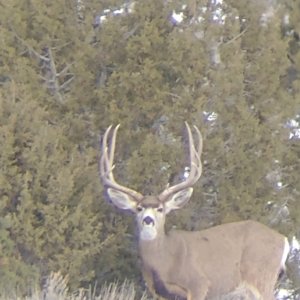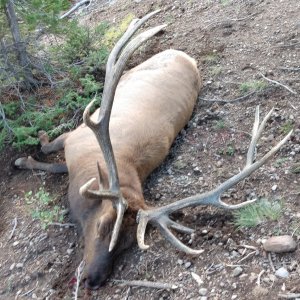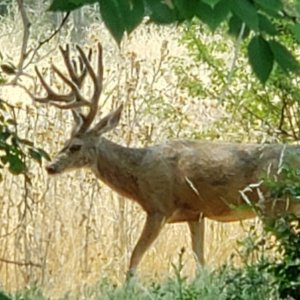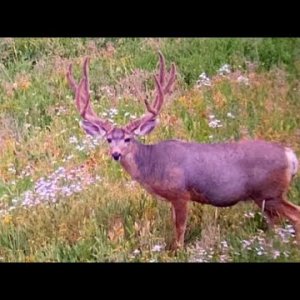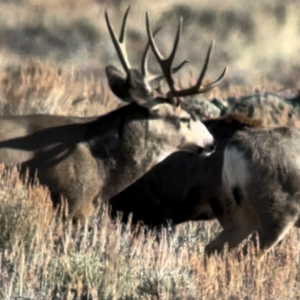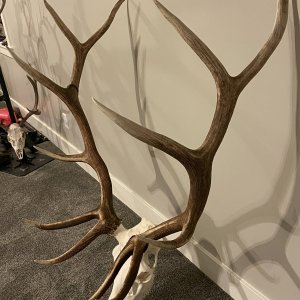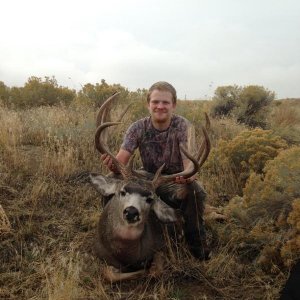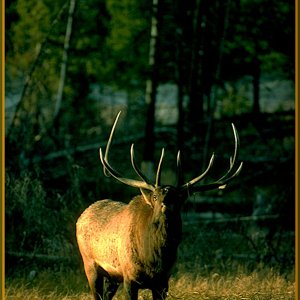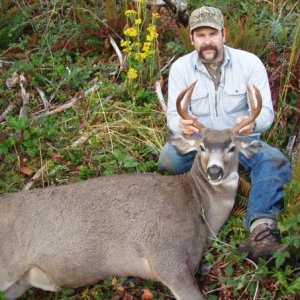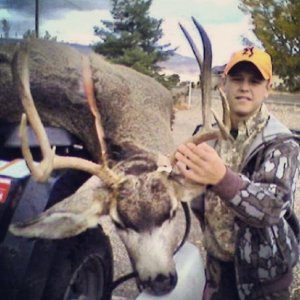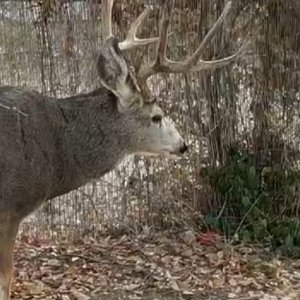T
TFinalshot
Guest
I thought they stopped using 1080 years ago, I was wrong. . .
By MATTHEW DALY
Associated Press writer
WASHINGTON -- Dennis Slaugh and his brother were riding all-terrain vehicles when they noticed what looked like a survey stake, marking federal land in eastern Utah's rugged Cowboy Canyon.
Curious, Slaugh touched the stake, and it exploded, spewing a cloud of sodium cyanide in his face and chest. Slaugh, 65, of Vernal, Utah, said he suffers long-term health effects from the 2003 spraying. He has difficulty breathing, vomits almost daily and can no longer work driving heavy equipment because he is too weak.
The cyanide device, called an M-44, is one of two poisons used by the federal government to kill coyotes and other wild animals that threaten sheep and other livestock. M-44 and sodium fluoroacetate, more commonly known as Compound 1080, are distributed by the Wildlife Services agency, an arm of the Agriculture Department. The poisons killed more than 14,000 wild animals in 2006, including coyotes, foxes and wolves, the agency reported.
Slaugh encountered the gas canister on public land in a canyon that empties into the White River near the Colorado state line. M-44 is also used to kill coyotes in Wyoming.
The Agriculture Department says the devices are a relatively humane way to kill predatory animals, adding that because the poison is contained in specific delivery devices, the risk to non-target animals is reduced.
Compound 1080 is used in "livestock protection collars" strapped onto sheep or goats, while sodium cyanide is used in an ejector that has bait designed to attract predators but not livestock. It releases poison into the wild animal's mouth.
After years of complaints by environmental groups, the Environmental Protection Agency said last week it is investigating Slaugh's poisoning, which critics say is only one of a host of mishaps in which hundreds of dogs and other pets have been killed, and dozens of people have been poisoned or injured.
"It's only a matter of time before someone is killed," said Brooks Fahy, executive director of Predator Defense, an Oregon-based group that works to protect coyotes and other wildlife.
"These devices cannot differentiate between a coyote, a wolf, a dog or a person," Fahy said. "When pulled on, even lightly, the device spews enough sodium cyanide to kill a person."
The EPA investigation comes as the agency considers a proposal to prohibit use of the poisons on federal land. A bill by Rep. Peter DeFazio, D-Ore., would go further, banning the poisons altogether.
"Compound 1080 and M-44 sodium cyanide capsules are lethal, dangerous, and unnecessary poisons. They pose a very serious threat to our nation's citizens, wildlife and domesticated animals," DeFazio said.
He called the two toxins "super poisons" that could be used by terrorists to harm Americans. Compound 1080 is so lethal that a single teaspoonful could kill dozens of people. There is no known antidote.
Rep. John Salazar, D-Colo., called DeFazio's fears overstated.
A farmer and cattle rancher, Salazar said both pesticides are safe, "environmentally sound tools registered by the Environmental Protection Agency and used only by trained and certified applicators."
Use of the pesticides "is highly target-specific, in limited applications, and in compliance with the regulations of the EPA and local jurisdictions," Salazar wrote in a letter urging colleagues to defeat DeFazio's bill.
Without effective tools to protect them from predators, livestock losses from coyotes and other wildlife could be two to three times higher than current levels -- estimated at $16.3 million per year in the sheep industry and $51 million in cattle losses, according to the Colorado Wool Growers Association, which represents the state's 1,600 sheep farms and ranches.
"Regardless of the size of operation, each sheep farm or ranch needs protection against predators, and many operations rely on the assistance and expertise" provided by the Wildlife Services agency, the group said in a letter opposing the ban.
Salazar encouraged colleagues to "stand up for the thousands of livestock producers in our country who provide the world's most abundant food supply and oppose this legislation."
The bill comes as the EPA has taken a long-delayed step toward banning use of the poisons on federal lands. The agency has set a March 5 deadline for public comments on a proposal drafted in response to a petition from a coalition of environmental groups.
EPA has not reached a decision on the petition and is conducting its own analysis to determine if the pesticides "pose unreasonable adverse effects on the environment," said Dale Kemery, an agency spokesman.
Compound 1080 is made primarily by Alabama-based Tull Chemical Co., while M-44 capsules are produced by the Agriculture Department's Pocatello Supply Depot in Idaho. Warning signs in English and Spanish are required near locations where the poisons are used.
By MATTHEW DALY
Associated Press writer
WASHINGTON -- Dennis Slaugh and his brother were riding all-terrain vehicles when they noticed what looked like a survey stake, marking federal land in eastern Utah's rugged Cowboy Canyon.
Curious, Slaugh touched the stake, and it exploded, spewing a cloud of sodium cyanide in his face and chest. Slaugh, 65, of Vernal, Utah, said he suffers long-term health effects from the 2003 spraying. He has difficulty breathing, vomits almost daily and can no longer work driving heavy equipment because he is too weak.
The cyanide device, called an M-44, is one of two poisons used by the federal government to kill coyotes and other wild animals that threaten sheep and other livestock. M-44 and sodium fluoroacetate, more commonly known as Compound 1080, are distributed by the Wildlife Services agency, an arm of the Agriculture Department. The poisons killed more than 14,000 wild animals in 2006, including coyotes, foxes and wolves, the agency reported.
Slaugh encountered the gas canister on public land in a canyon that empties into the White River near the Colorado state line. M-44 is also used to kill coyotes in Wyoming.
The Agriculture Department says the devices are a relatively humane way to kill predatory animals, adding that because the poison is contained in specific delivery devices, the risk to non-target animals is reduced.
Compound 1080 is used in "livestock protection collars" strapped onto sheep or goats, while sodium cyanide is used in an ejector that has bait designed to attract predators but not livestock. It releases poison into the wild animal's mouth.
After years of complaints by environmental groups, the Environmental Protection Agency said last week it is investigating Slaugh's poisoning, which critics say is only one of a host of mishaps in which hundreds of dogs and other pets have been killed, and dozens of people have been poisoned or injured.
"It's only a matter of time before someone is killed," said Brooks Fahy, executive director of Predator Defense, an Oregon-based group that works to protect coyotes and other wildlife.
"These devices cannot differentiate between a coyote, a wolf, a dog or a person," Fahy said. "When pulled on, even lightly, the device spews enough sodium cyanide to kill a person."
The EPA investigation comes as the agency considers a proposal to prohibit use of the poisons on federal land. A bill by Rep. Peter DeFazio, D-Ore., would go further, banning the poisons altogether.
"Compound 1080 and M-44 sodium cyanide capsules are lethal, dangerous, and unnecessary poisons. They pose a very serious threat to our nation's citizens, wildlife and domesticated animals," DeFazio said.
He called the two toxins "super poisons" that could be used by terrorists to harm Americans. Compound 1080 is so lethal that a single teaspoonful could kill dozens of people. There is no known antidote.
Rep. John Salazar, D-Colo., called DeFazio's fears overstated.
A farmer and cattle rancher, Salazar said both pesticides are safe, "environmentally sound tools registered by the Environmental Protection Agency and used only by trained and certified applicators."
Use of the pesticides "is highly target-specific, in limited applications, and in compliance with the regulations of the EPA and local jurisdictions," Salazar wrote in a letter urging colleagues to defeat DeFazio's bill.
Without effective tools to protect them from predators, livestock losses from coyotes and other wildlife could be two to three times higher than current levels -- estimated at $16.3 million per year in the sheep industry and $51 million in cattle losses, according to the Colorado Wool Growers Association, which represents the state's 1,600 sheep farms and ranches.
"Regardless of the size of operation, each sheep farm or ranch needs protection against predators, and many operations rely on the assistance and expertise" provided by the Wildlife Services agency, the group said in a letter opposing the ban.
Salazar encouraged colleagues to "stand up for the thousands of livestock producers in our country who provide the world's most abundant food supply and oppose this legislation."
The bill comes as the EPA has taken a long-delayed step toward banning use of the poisons on federal lands. The agency has set a March 5 deadline for public comments on a proposal drafted in response to a petition from a coalition of environmental groups.
EPA has not reached a decision on the petition and is conducting its own analysis to determine if the pesticides "pose unreasonable adverse effects on the environment," said Dale Kemery, an agency spokesman.
Compound 1080 is made primarily by Alabama-based Tull Chemical Co., while M-44 capsules are produced by the Agriculture Department's Pocatello Supply Depot in Idaho. Warning signs in English and Spanish are required near locations where the poisons are used.

